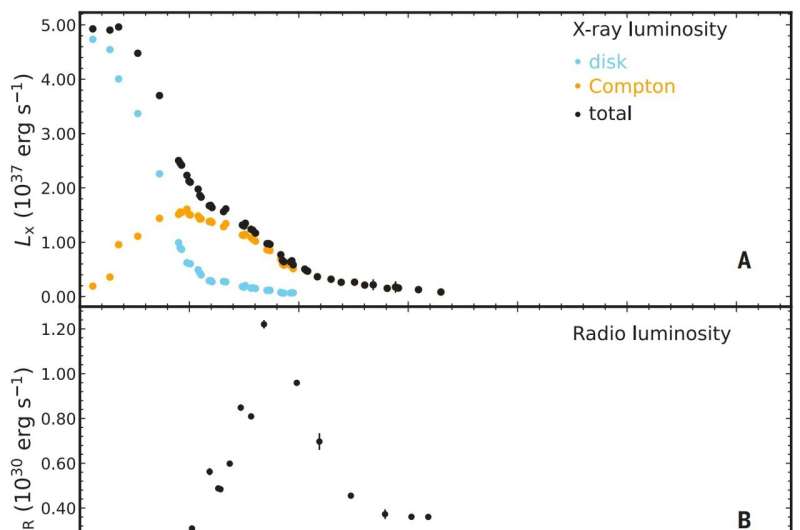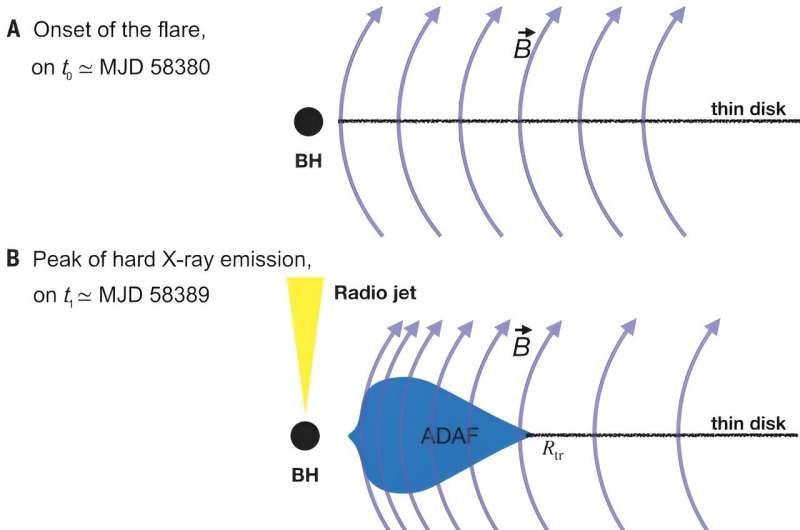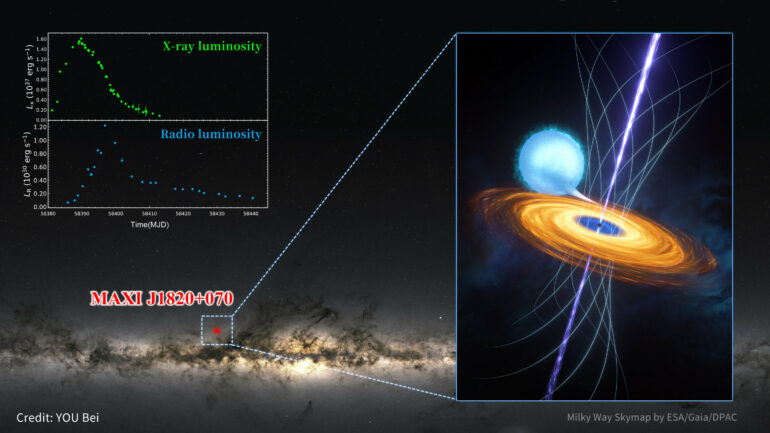An international scientific team has revealed for the first time the magnetic field transport processes in the accretion flow of a black hole and the formation of a “MAD”—a magnetically arrested disk—in the vicinity of a black hole.
The researchers made the discovery while conducting multi-wavelength observational studies of an outburst event of the black hole X-ray binary MAXI J1820+070, using Insight-HXMT, China’s first X-ray astronomical satellite, as well as multiple telescopes.
Key to their discovery was the observation that the radio emission from the black hole jet and the optical emission from the outer region of the accretion flow lag behind the hard X-rays from the hot gas in the inner region of the accretion flow (i.e., the hot accretion flow) by about eight days and 17 days, respectively.
These findings were published in Science on Aug. 31.
The study was led by Assoc. Prof. You Bei from Wuhan University, Prof. Cao Xinwu from Zhejiang University and Prof. Yan Zhen from the Shanghai Astronomical Observatory (SHAO) of the Chinese Academy of Sciences.
The process of a black hole capturing gas is known as “accretion,” and the gas falling into the black hole is referred to as an accretion flow. The viscous processes within the accretion flow effectively release gravitational potential energy, with a portion of the energy being converted into multi-wavelength radiation. This radiation can be observed by ground-based and space telescopes, allowing us to “see” the black hole.

Multi-wavelength light curves (showing the change in brightness over time) of the black hole X-ray binary MAXI J1820+070. © SHAO
However, there are “unseen” magnetic fields around the black hole. As the black hole accretes gas, it also drags the magnetic field inwards. Previous theories suggested that as the accreting gas continuously brings in weak external magnetic fields, the magnetic field progressively strengthens towards the inner region of the accretion flow.
The outward magnetic force on the accretion flow increases and counteracts the inward gravitational pull from the black hole. Therefore, in the inner region of the accretion flow near the black hole, when the magnetic field reaches a certain strength, the accreted matter becomes trapped by the magnetic field and cannot freely fall into the black hole. This phenomenon is known as a magnetically arrested disk.
The MAD theory was proposed many years ago and has successfully explained some observational phenomena related to black hole accretion. However, no direct observational evidence for the existence of a MAD was available, and MAD formation and magnetic transport mechanisms remained mysteries.
In addition to the supermassive black holes at the centers of nearly every galaxy, there are also many more stellar-mass black holes in the universe. Astronomers have detected stellar-mass black holes in many binary star systems in the Milky Way. These black holes generally have a mass about ten times that of the sun.
Most of the time, these black holes are in a quiescent state, emitting extremely weak electromagnetic radiation. However, they occasionally enter an outburst period that can last for several months or even years, producing bright X-rays. As a result, these types of binary star systems are often referred to as black hole X-ray binaries.
In this study, the researchers performed a multi-wavelength data analysis of the outburst of the black hole X-ray binary MAXI J1820+070. They observed that the hard X-ray emission exhibited a peak that was followed by a peak in radio emission eight days later. Such a long delay between radio emission from the jet and the hard X-rays from the hot accretion flow is unprecedented.
These observations indicate that the weak magnetic field in the outer region of the accretion disk is carried into the inner region by the hot gas, and the radial extent of the hot accretion flow rapidly expands as the accretion rate decreases. The greater the radial extent of the hot accretion flow, the greater the increase in the magnetic field. This leads to a rapid strengthening of the magnetic field near the black hole, resulting in the formation of a MAD approximately eight days after the peak of the hard X-ray emission.

Schematic representation of accretion flow, magnetic field, and jet evolution. © SHAO
“Our study for the first time reveals the process of magnetic field transport in the accretion flow and the process of MAD formation in the vicinity of the black hole. This represents the direct observational evidence for the existence of a magnetically arrested disk,” said Assoc. Prof. You Bei, first author and co-corresponding author of the study.
Additionally, the research team observed an unprecedented delay (about 17 days) between the optical emission from the outer region of the accretion flow and the hard X-rays from the hot accretion flow. Through numerical simulations of the outburst of the black hole X-ray binary, it was discovered that as the outburst approaches the end, the irradiation of hard X-rays causes more accreting material from the far outer region to fall towards the black hole due to instability. This leads to an optical flare in the outer region of the accretion flow, with the peak occurring about 17 days after the peak of the hard X-rays from the hot accretion flow.
“Due to the universality of black hole accretion physics, where accretion processes for black holes of different mass scales follow the same physical laws, this research will advance the understanding of scientific questions related to large-scale magnetic field formation, jet powering, and acceleration mechanisms for accreting black holes of different mass scales,” said Prof. Cao Xinwu, co-corresponding author of the study.
Similar phenomena to those observed in MAXI J1820+070 are expected to be observed in more accreting black hole systems in the near future, noted Prof. Yan Zhen, co-corresponding author of the study.
More information:
Bei You et al, Observations of a black hole X-ray binary indicate formation of a magnetically arrested disk, Science (2023). DOI: 10.1126/science.abo4504. www.science.org/doi/10.1126/science.abo4504
Provided by
Chinese Academy of Sciences
Citation:
How does ‘MAD’ accretion form around a black hole? (2023, August 31)



